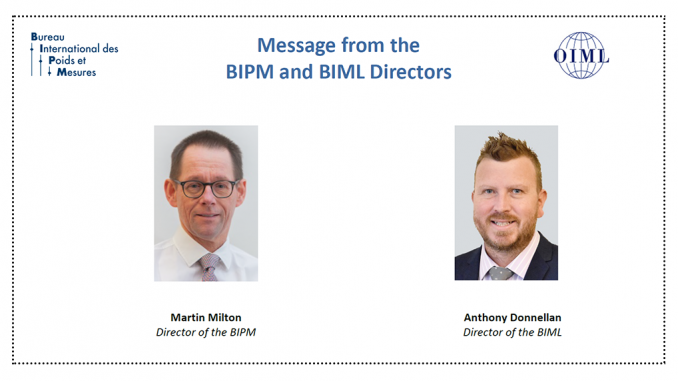“The SI – fundamentally better”

The International System of Units (SI) is the accepted set of units for all applications of measurement worldwide. Although one of its aims is to provide the basis for measurements that are stable over long periods of time, it has always been a practical and dynamic system that has changed to exploit the latest scientific advances.
In November 2018, the General Conference on Weights and Measures met in Versailles and agreed one of the most significant sets of changes to the SI since its inception in 1960. These were to base it on our best understanding of the laws of nature and to eliminate the link between the SI and definitions based on physical artefacts. The changes build on the results of research into new measurement methods that use quantum phenomena as the basis for standards that are fundamental.
These changes were agreed in November 2018 and come into force on May 20th 2019, a date chosen because it is the anniversary of the signature of the Metre Convention, celebrated by World Metrology Day. Whilst the future impact of the changes will be far reaching, great attention has been paid to ensure that the new definitions will be compatible with the current ones at the time the change is implemented. The changes will not be noticeable to any but the most demanding users, but, they do mean that there may be changes in the way that traceability is ultimately established. The global work to harmonize the operation of instruments used to make measurements will continue to ensure that trade, industry and consumers will not notice any difference to the weights, lengths and other measures they use.
The new definitions use ‘the rules of nature to create the rules of measurement’, linking measurements at the atomic and quantum scales to those at the macroscopic level. They achieve a collective ambition for the “metric system” which has been to provide universality of access to the agreed basis for worldwide measurements. They will provide the basis for future innovations in measurements that will allow the definitions of the second, the metre, the ampere and the kelvin to take advantage of atomic and quantum phenomena to achieve levels of accuracy limited only by our capacity to observe them.
Information for users about the proposed revision of the SI
The International System of Units1, the SI, which is based on the second, the metre, the kilogram, the ampere, the kelvin, the mole and the candela (the base units), is being revised to update the definitions of four of these units. In November 2018 revised definitions of the kilogram, ampere, kelvin and mole are expected to be approved by the General Conference on Weights and Measures (CGPM), the international body responsible for the global comparability of measurements. The revised definitions are expected to come into force on 20 May 2019.
The revised definitions will be based on seven physical constants (for example the speed of light, the Planck constant and the Avogadro constant) and are therefore inherently stable. The quantities have been chosen so that the revised definitions will not need to be modified to accommodate future improvements in the technologies used to realize them. The revision of the SI in this way was foreseen in Resolutions of the CGPM adopted in 2011 and 20142,3. Additional requirements contained in these Resolutions will ensure a smooth transition to the four revised definitions. Most users will not notice the change. A new edition of the SI Brochure1 will provide essential information for users and will be available after the revised definitions are adopted formally. Guidance on the practical realization of the units will be available4-8.
Some information about how these changes might affect the different areas of measurement is given below:
• The kilogram will be defined in terms of the Planck constant, guaranteeing long-term stability of the SI mass scale. The kilogram can then be realized by any suitable method, (for example the Kibble (watt) balance or the Avogadro (X-ray crystal density) method). Users will be able to obtain traceability to the SI from the same sources used at present (the BIPM, national metrology institutes and accredited laboratories). International comparisons will ensure their consistency. The value of the Planck constant will be chosen to ensure that there will be no change in the SI kilogram at the time of redefinition. The uncertainties offered by NMIs to their calibration customers will also be broadly unaffected.
• The ampere and other electrical units, as practically realized at the highest metrological level, will become fully consistent with the definitions of these units. The transition from the 1990 convention to the revised SI will result in small changes to all disseminated electrical units. For the vast majority of measurement users, no action need be taken as the volt will change by about 0.1 parts per million and the ohm will change by even less. Practitioners working at the highest level of accuracy may need to adjust the values of their standards and review their measurement uncertainty budgets.
• The kelvin will be redefined with no immediate effect on temperature measurement practice or on the traceability of temperature measurements, and for most users, it will pass unnoticed. The redefinition lays the foundation for future improvements. A definition free of material and technological constraints enables the development of new and more accurate techniques for making temperature measurements traceable to the SI, especially at extremes of temperature. After the redefinition, the guidance on the practical realization of the kelvin will support its world-wide dissemination by describing primary methods for measurement of thermodynamic temperature and equally through the defined scales ITS-90 and PLTS-2000.
• The mole will be redefined with respect to a specified number of entities (typically atoms or molecules) and will no longer depend on the unit of mass, the kilogram. Traceability to the mole can still be established via all previously employed approaches including, but not limited to, the use of mass measurements along with tables of atomic weights and the molar mass constant Mu. Atomic weights will be unaffected by this change in definition and Mu will still be 1 g/mol, although now with a measurement uncertainty. This uncertainty will be so small that the revised definition of the mole will not require any change to common practice.
The revised definitions of the kilogram, ampere, kelvin and mole will have no impact on the second, the metre and the candela.
• The second will continue to be defined in terms of the hyperfine transition frequency of the caesium 133 atom. The traceability chain to the second will not be affected. Time and frequency metrology will not be impacted.
• The metre in the revised SI will continue to be defined in terms of the speed of light, one of the fundamental constants of physics. Dimensional metrology practice will not need to be modified in any way and will benefit from the improved long-term stability of the system.
• The candela will continue to be defined in terms of Kcd, a technical constant for photometry and will therefore continue to be linked to the watt. Traceability to the candela will still be established with the same measurement uncertainty via radiometric methods using absolutely-calibrated detectors.
The SI has been revised several times since its formal adoption by the CGPM in 1960. However, redefining four base units at one time is unprecedented, requiring simultaneous world-wide collaborations in diverse fields of metrology. As in the past, care has been taken to ensure that there will be no perceptible impact on daily life and that measurements made with previous definitions of the units remain valid within their measurement uncertainties. Few users outside national metrology laboratories will notice the changes. Reaching the experimental accuracies and fulfilling the conditions requested in the CGPM resolutions has been a remarkable accomplishment, which will ensure that the SI continues to meet the needs of even the most demanding users.
1. http://www.bipm.org/en/publications/si-brochure/
2. http://www.bipm.org/en/CGPM/db/24/1/
3. http://www.bipm.org/en/CGPM/db/25/1/
4. http://www.bipm.org/en/publications/mises-en-pratique/
5. http://www.bipm.org/cc/CCM/Allowed/15/02A_MeP_kg_141022_v-9.0_clean.pdf
6. http://www.bipm.org/cc/CCEM/Allowed/26/CCEM-09-05.pdf1.
7. http://www.bipm.org/cc/CCT/…/MeP-K-14_DRAFT_Dec_2015.pdf
8. http://www.bipm.org/cc/CCQM/Allowed/22/CCQM16-04_Mole_m_en_p_draft.pdf
This note was prepared by the Consultative Committees of the CIPM in 2017 for the purpose of creating awareness of the revision of the International System of Units expected for 2018.
